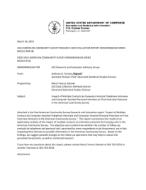Impact of Multiple Contacts by Computer-Assisted Telephone Interview and Computer-Assisted Personal Interview on Final Interview Outcome in the American Community Survey
Impact of Multiple Contacts by Computer-Assisted Telephone Interview and Computer-Assisted Personal Interview on Final Interview Outcome in the American Community Survey
A Congressional hearing on the American Community Survey (ACS) included testimony that the Census Bureau repeatedly contacted households that did not want to participate. We undertook this research to better understand the use and impact of multiple contacts in the ACS. During the mailout/mailback month, sample households can receive up to five mailing pieces (six starting with the January 2013 ACS production sample). During nonresponse follow-up by Computer-Assisted Telephone Interviewing (CATI), cases are closed out after an interview, two refusals, four hang-ups, 20 unproductive calls, 25 calls if contact is made with the household, or the month ends. Computer-Assisted Personal Interviewing (CAPI) follow-up operations close a case after an interview, a refusal that cannot be converted by a field supervisor, an interviewerâs monthly allocation of interview time has expired (which is about 2.2 hours per case on average nationwide), or the month ends. In light of the potentially high number of contact attempts in CATI and CAPI, we designed this research to determine if we could reduce multiple contacts (and perceived harassment by some households) while still maintaining the current high response rate.
The results from this research will help determine the next steps in CATI and CAPI methodology. Specifically, managers can use these results to determine the ideal number of contacts that will provide the best interview outcome depending on the early disposition of the case. If the results indicate that reducing the number of contacts does not harm the final interview outcome rate, we may conduct additional research, including testing variations of the number of CATI and CAPI contacts attempted for each sampled address and looking into any potential nonresponse bias to data items. The results of this study may also provide additional insight for the mode switch research currently being conducted at the Census Bureau. Methodology This research looked at the impact of multiple contacts in the CATI and CAPI modes on the final ACS interview outcome. The focus of the analysis was to examine intermediate outcomes and their associated final outcomes in each mode to determine if there was an optimal course of action after receiving initial resistance from a respondent. We used paradata from both ACS CATI and CAPI production operations (June 2011 to February 2012 panels) to answer the research questions.
Others in Series
Working Paper
Working Paper
Working Paper




